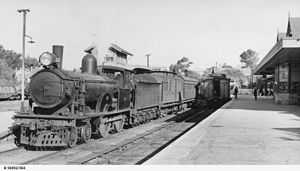South Australian Railways S class
| South Australian Railways S class[1] | |
|---|---|
|
Passenger train No. 131 at Murray Bridge, 5 March 1951 | |
| Type and origin | |
| Power type | Steam |
| Builder | James Martin & Co, |
| Build date | 1894 |
| Total produced | 18 |
| Specifications | |
| Configuration | 4-4-0 |
| UIC classification | 2′B 2′2′ |
| Gauge | 5 ft 3 in (1,600 mm) |
| Driver diameter | 6 ft 6 in (1.981 m) |
| Length | 57 ft 5⁄8 in (17.389 m) |
| Locomotive weight | 87,360 lb (39,625.829 kg) |
| Tender weight | 96,746 lb (43,883.247 kg) |
| Locomotive and tender combined weight | 184,106 lb (83,509.077 kg) |
| Fuel type | Coal |
| Fuel capacity | 7 tons 16 cwt, 4 tons 18 cwt 3qtr (6 wheel tender) |
| Water capacity | 4,120 gallons, 2,040 gallons (6 wheel tender) |
| Boiler pressure | 150 psi (1,034 kPa) |
| Heating surface: – Tubes | 1,038 square feet |
| – Tubes and flues | 100.24 square feet |
| Cylinders | Two, |
| Cylinder size | 18 in × 24 in (457 mm × 610 mm) |
| Valve gear | Stephenson |
| Performance figures | |
| Tractive effort | 12,711 lbf (56.54 kN) |
| Career | |
| Operator(s) | South Australian Railways |
| Number(s) | 11, 13-14, 17, 26, 50+ |
| Delivered | 1894-1904 |
| First run | 1894 |
| Scrapped | 1956–1961 |
| Disposition | 18 Scrapped |
The South Australian Railways S Class is broad gauge, 1,600 mm (5 ft 3 in), 4-4-0 steam locomotives, designed as an express locomotive for the route between Murray Bridge and the border with Victoria. The S class had 6'6" driving wheels, the largest of any Australian locomotive, to give it high speeds on low grades.[1]
The engines were pushed out of main line service in the 1920s by 600 class locomotives and Brill railcars. They continued to serve on secondary service into the 1950s with the last examples being retired in 1961.[1]
No S class locomotives survived to this day. One engine was set aside for preservation, however it was inadvertently scrapped.
References
- ↑ 1.0 1.1 1.2 Llanso, Steve. "South Australian Railways 4-4-0 Locomotives". SteamLocomotive.com.
| ||||||||||||||||||||||||||
